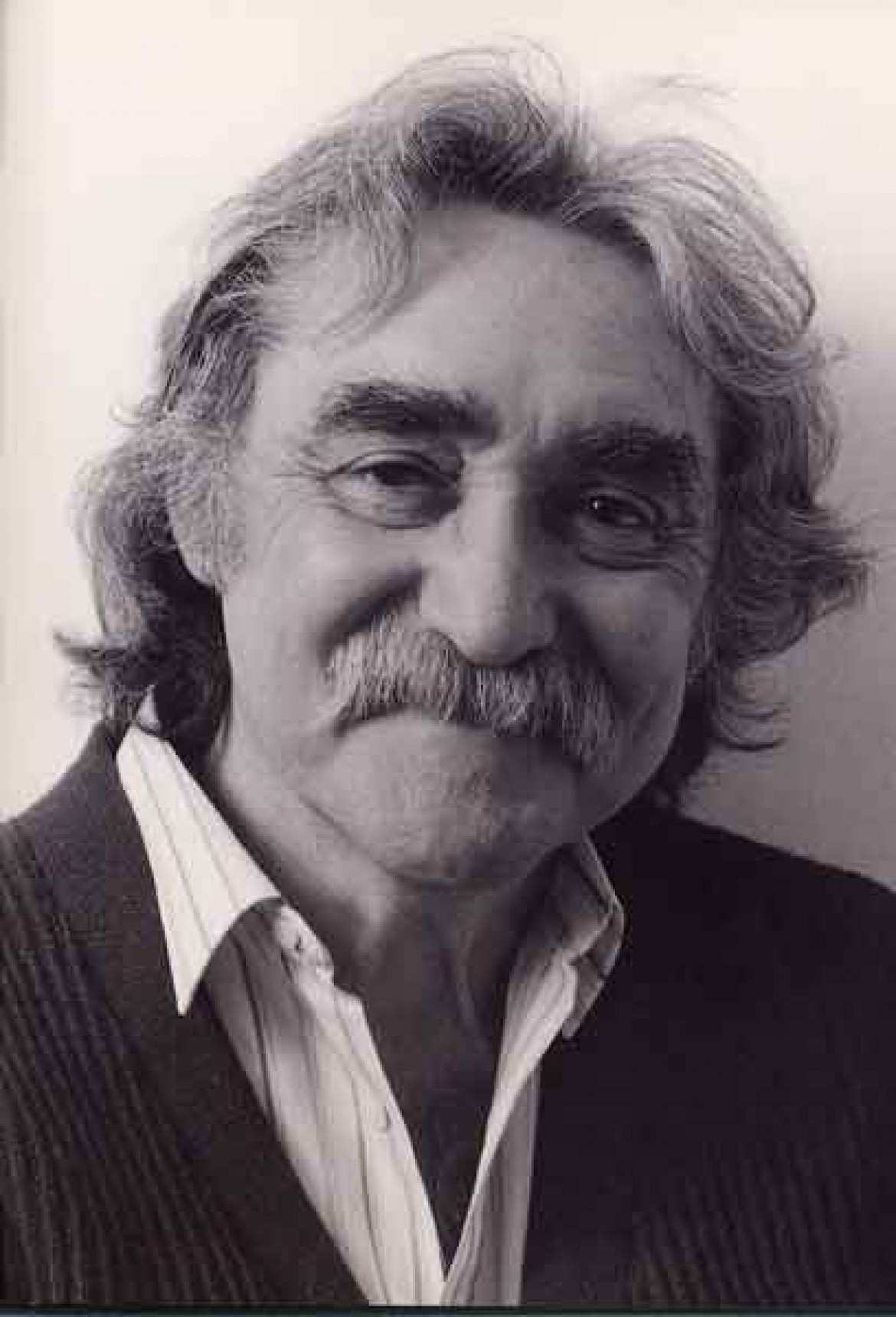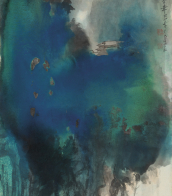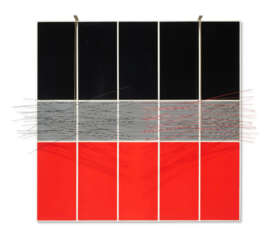2005

Zdzisław Beksiński was a Polish painter, photographer, and sculptor, specializing in the field of dystopian surrealism.
Beksiński made his paintings and drawings in what he called either a Baroque or a Gothic manner. His creations were made mainly in two periods. The first period of work is generally considered to contain expressionistic color, with a strong style of «utopian realism» and surreal architecture, like a doomsday scenario. The second period contained more abstract style, with the main features of formalism.


Zdzisław Beksiński was a Polish painter, photographer, and sculptor, specializing in the field of dystopian surrealism.
Beksiński made his paintings and drawings in what he called either a Baroque or a Gothic manner. His creations were made mainly in two periods. The first period of work is generally considered to contain expressionistic color, with a strong style of «utopian realism» and surreal architecture, like a doomsday scenario. The second period contained more abstract style, with the main features of formalism.


Piero Dorazio was an Italian painter. His work was related to color field painting, lyrical abstraction and other forms of abstract art.


Jesús Rafael García Soto was a Venezuelan artist, renowned for his pioneering work in kinetic and op art, which sought to create an immersive experience that blurred the lines between the artwork and the viewer. Born in 1923, Soto embarked on a journey that would see him at the forefront of a movement that emphasized the visual dynamics of art, integrating sculpture, painting, and viewer participation in novel ways. His exploration of geometric abstraction and optical effects led to the development of his distinctive style, characterized by the use of materials such as plexiglass to create engaging optical illusions and vibrant, moving sculptures.
Soto's journey into the realms of kinetic art was marked by significant milestones, including his participation in the groundbreaking 1955 exhibition, Le Mouvement, at the Denise René gallery in Paris. This event was instrumental in defining the kinetic art movement, with Soto alongside artists like Yaacov Agam, Marcel Duchamp, and Victor Vasarely, presenting works that invited viewers to experience art in a dynamic, interactive manner. His quest for a new visual language led him to experiment with the dematerialization of form, creating artworks that seemed to dissolve into their surroundings, thereby challenging the viewer's perceptions of space and form.
Throughout his career, Soto remained dedicated to exploring the intrinsic relationships between space, movement, and viewer perception. His creations, ranging from the "Penetrables" series—immersive environments made of hanging strands that visitors could walk through—to large-scale murals and public sculptures, have been celebrated worldwide. His works are part of major collections and have been exhibited extensively, including at institutions such as the Museum of Modern Art in New York and the Tate Gallery in London, demonstrating his lasting influence on contemporary art.
For art collectors and enthusiasts intrigued by the fusion of art and motion, Jesús Rafael García Soto's work offers a profound exploration of the kinetic art movement's possibilities. His contributions to art are not just visual spectacles but invitations to engage directly with the kinetic energy and vibrancy of the world.
To stay updated on exhibitions and sales featuring Jesús Rafael García Soto's work, sign up for updates. This subscription ensures you're informed about new product sales and auction events related to this visionary artist, offering unique opportunities to experience the dynamism of kinetic art firsthand.


Patrick Caulfield was an English painter and printmaker renowned for his distinct approach to art, which often combined elements of photorealism within simplified scenes. Born in London in 1936, Caulfield's artistic journey led him to become a significant figure associated with the British Pop Art movement, though he personally refuted this label, aligning more closely with early European Modernist traditions. His works are celebrated for their bold canvases, characterized by sleek lines, bold colors, and an intriguing blend of the real and the abstract, held in esteemed collections worldwide, including those of Charles Saatchi and David Bowie.
Caulfield's art is recognized for its innovative use of light, space, and color, creating a unique narrative that transcends the conventional boundaries of painting. Noteworthy pieces like "Pony" (1964) and "After Lunch" (1975) exemplify his skill in blending painting styles, creating "pictures within pictures" that challenge viewers' perceptions of space and reality. Caulfield's interiors, such as "Dining Recess" (1972) and "Tandoori Restaurant" (1971), convey a sense of melancholy and loneliness through their depiction of everyday spaces devoid of human presence, making his work profoundly resonant.
Throughout his career, Caulfield received several commissions, contributing to public spaces and collections across the globe. His art has been exhibited in numerous solo exhibitions, including at Tate Britain and the Royal Academy in London, underscoring his influence and importance in the art world.
For art collectors and experts, Patrick Caulfield's work offers a unique perspective on the everyday, merging the abstract with the real in ways that continue to captivate and intrigue. To stay updated on sales and auction events related to Patrick Caulfield's art, signing up for updates is highly recommended, ensuring access to the latest offerings and insights into his enduring legacy.


Piero Dorazio was an Italian painter. His work was related to color field painting, lyrical abstraction and other forms of abstract art.


Piero Dorazio was an Italian painter. His work was related to color field painting, lyrical abstraction and other forms of abstract art.


Bernard Schultze was a German painter who co-founded the Quadriga group of artists along with Karl Otto Götz and two other artists.


Bernard Schultze was a German painter who co-founded the Quadriga group of artists along with Karl Otto Götz and two other artists.


Zdzisław Beksiński was a Polish painter, photographer, and sculptor, specializing in the field of dystopian surrealism.
Beksiński made his paintings and drawings in what he called either a Baroque or a Gothic manner. His creations were made mainly in two periods. The first period of work is generally considered to contain expressionistic color, with a strong style of «utopian realism» and surreal architecture, like a doomsday scenario. The second period contained more abstract style, with the main features of formalism.


Zdzisław Beksiński was a Polish painter, photographer, and sculptor, specializing in the field of dystopian surrealism.
Beksiński made his paintings and drawings in what he called either a Baroque or a Gothic manner. His creations were made mainly in two periods. The first period of work is generally considered to contain expressionistic color, with a strong style of «utopian realism» and surreal architecture, like a doomsday scenario. The second period contained more abstract style, with the main features of formalism.


Zdzisław Beksiński was a Polish painter, photographer, and sculptor, specializing in the field of dystopian surrealism.
Beksiński made his paintings and drawings in what he called either a Baroque or a Gothic manner. His creations were made mainly in two periods. The first period of work is generally considered to contain expressionistic color, with a strong style of «utopian realism» and surreal architecture, like a doomsday scenario. The second period contained more abstract style, with the main features of formalism.


Armand Pierre Fernandez, widely known by his mononym Arman, was a French-born American artist celebrated for his innovative contributions to the Nouveau Réalisme movement and his radical use of everyday objects in art. Born in Nice, France, on November 17, 1928, Arman's early exposure to art came from his father, an antiques dealer and amateur artist, which deeply influenced his later artistic endeavors.
Arman moved beyond traditional painting techniques early in his career, instead creating his signature "Accumulations" and "Poubelles" (trash) sculptures. These works involved assembling and compacting everyday items like watches, clocks, and even automobiles, embedding these objects in layers of concrete or encasing them in Plexiglas. One of his most notable large-scale works is "Long Term Parking," a 60-foot high sculpture made of concrete-encased cars, situated in Jouy-en-Josas, France.
His work is an essential bridge between European and American trends in Pop art and has been widely exhibited in major institutions like the Metropolitan Museum of Art in New York, the Tate Gallery in London, and the Centre Pompidou in Paris. Arman's innovative techniques and philosophical approach to materials challenged conventional categorizations of art and inspired future generations of artists.
For collectors and enthusiasts interested in staying updated on exhibitions and sales related to Arman's work, signing up for updates can provide essential insights and opportunities related to this influential artist. Join our community to ensure you don't miss out on new discoveries and auction events associated with Arman's legacy.


Gerard Verdijk was a Dutch abstractionist painter who worked in a wide range of materials and techniques.
Curious and eager to learn new things, he traveled to Europe, Turkey, the Middle East, North America, Africa and Japan to experience other cultures.
Verdijk's work cannot be attributed to any one historical and artistic movement. The ever-changing world around him influenced his style and use of materials.


Armand Pierre Fernandez, widely known by his mononym Arman, was a French-born American artist celebrated for his innovative contributions to the Nouveau Réalisme movement and his radical use of everyday objects in art. Born in Nice, France, on November 17, 1928, Arman's early exposure to art came from his father, an antiques dealer and amateur artist, which deeply influenced his later artistic endeavors.
Arman moved beyond traditional painting techniques early in his career, instead creating his signature "Accumulations" and "Poubelles" (trash) sculptures. These works involved assembling and compacting everyday items like watches, clocks, and even automobiles, embedding these objects in layers of concrete or encasing them in Plexiglas. One of his most notable large-scale works is "Long Term Parking," a 60-foot high sculpture made of concrete-encased cars, situated in Jouy-en-Josas, France.
His work is an essential bridge between European and American trends in Pop art and has been widely exhibited in major institutions like the Metropolitan Museum of Art in New York, the Tate Gallery in London, and the Centre Pompidou in Paris. Arman's innovative techniques and philosophical approach to materials challenged conventional categorizations of art and inspired future generations of artists.
For collectors and enthusiasts interested in staying updated on exhibitions and sales related to Arman's work, signing up for updates can provide essential insights and opportunities related to this influential artist. Join our community to ensure you don't miss out on new discoveries and auction events associated with Arman's legacy.


Armand Pierre Fernandez, widely known by his mononym Arman, was a French-born American artist celebrated for his innovative contributions to the Nouveau Réalisme movement and his radical use of everyday objects in art. Born in Nice, France, on November 17, 1928, Arman's early exposure to art came from his father, an antiques dealer and amateur artist, which deeply influenced his later artistic endeavors.
Arman moved beyond traditional painting techniques early in his career, instead creating his signature "Accumulations" and "Poubelles" (trash) sculptures. These works involved assembling and compacting everyday items like watches, clocks, and even automobiles, embedding these objects in layers of concrete or encasing them in Plexiglas. One of his most notable large-scale works is "Long Term Parking," a 60-foot high sculpture made of concrete-encased cars, situated in Jouy-en-Josas, France.
His work is an essential bridge between European and American trends in Pop art and has been widely exhibited in major institutions like the Metropolitan Museum of Art in New York, the Tate Gallery in London, and the Centre Pompidou in Paris. Arman's innovative techniques and philosophical approach to materials challenged conventional categorizations of art and inspired future generations of artists.
For collectors and enthusiasts interested in staying updated on exhibitions and sales related to Arman's work, signing up for updates can provide essential insights and opportunities related to this influential artist. Join our community to ensure you don't miss out on new discoveries and auction events associated with Arman's legacy.


Zdzisław Beksiński was a Polish painter, photographer, and sculptor, specializing in the field of dystopian surrealism.
Beksiński made his paintings and drawings in what he called either a Baroque or a Gothic manner. His creations were made mainly in two periods. The first period of work is generally considered to contain expressionistic color, with a strong style of «utopian realism» and surreal architecture, like a doomsday scenario. The second period contained more abstract style, with the main features of formalism.


Zdzisław Beksiński was a Polish painter, photographer, and sculptor, specializing in the field of dystopian surrealism.
Beksiński made his paintings and drawings in what he called either a Baroque or a Gothic manner. His creations were made mainly in two periods. The first period of work is generally considered to contain expressionistic color, with a strong style of «utopian realism» and surreal architecture, like a doomsday scenario. The second period contained more abstract style, with the main features of formalism.


Zdzisław Beksiński was a Polish painter, photographer, and sculptor, specializing in the field of dystopian surrealism.
Beksiński made his paintings and drawings in what he called either a Baroque or a Gothic manner. His creations were made mainly in two periods. The first period of work is generally considered to contain expressionistic color, with a strong style of «utopian realism» and surreal architecture, like a doomsday scenario. The second period contained more abstract style, with the main features of formalism.


Zdzisław Beksiński was a Polish painter, photographer, and sculptor, specializing in the field of dystopian surrealism.
Beksiński made his paintings and drawings in what he called either a Baroque or a Gothic manner. His creations were made mainly in two periods. The first period of work is generally considered to contain expressionistic color, with a strong style of «utopian realism» and surreal architecture, like a doomsday scenario. The second period contained more abstract style, with the main features of formalism.


Zoran Anton Mušič is a Slovenian painter and graphic artist who has worked in Italy and France.
Zoran studied painting in Maribor and Zagreb, then went to Madrid and Toledo for a year, where he studied and copied works by Goya and El Greco. At the end of 1944, he became a prisoner of the Nazi concentration camp Dachau, where he spent several months. He survived and even made about two hundred drawings on paper in the camp. After his liberation, Mušić moved to Venice and later to Paris.
Zoran Mušić was the only artist of Slovenian origin who managed to establish himself in the elite cultural circles of Italy and France, especially in Paris in the second half of the 20th century, where he lived most of his later life. He painted landscapes, still lifes, portraits and self-portraits, as well as horror scenes from the Dachau concentration camp and Vedute Venice. In 1970-1971, the artist created a pictorial reminiscence cycle "We are not the last", dedicated to concentration camp prisoners and became the most famous of his works.
The figures in Mušić's paintings appear out of empty space and seem unfinished. The colors of his self-portraits are the harsh colors of the desert, eliminating the superfluous and reducing to a minimum. These paintings are evidence of the artist's search for answers to the basic questions of human existence.


Armand Pierre Fernandez, widely known by his mononym Arman, was a French-born American artist celebrated for his innovative contributions to the Nouveau Réalisme movement and his radical use of everyday objects in art. Born in Nice, France, on November 17, 1928, Arman's early exposure to art came from his father, an antiques dealer and amateur artist, which deeply influenced his later artistic endeavors.
Arman moved beyond traditional painting techniques early in his career, instead creating his signature "Accumulations" and "Poubelles" (trash) sculptures. These works involved assembling and compacting everyday items like watches, clocks, and even automobiles, embedding these objects in layers of concrete or encasing them in Plexiglas. One of his most notable large-scale works is "Long Term Parking," a 60-foot high sculpture made of concrete-encased cars, situated in Jouy-en-Josas, France.
His work is an essential bridge between European and American trends in Pop art and has been widely exhibited in major institutions like the Metropolitan Museum of Art in New York, the Tate Gallery in London, and the Centre Pompidou in Paris. Arman's innovative techniques and philosophical approach to materials challenged conventional categorizations of art and inspired future generations of artists.
For collectors and enthusiasts interested in staying updated on exhibitions and sales related to Arman's work, signing up for updates can provide essential insights and opportunities related to this influential artist. Join our community to ensure you don't miss out on new discoveries and auction events associated with Arman's legacy.


Olga Albizu Rosaly was an abstract expressionist painter from Ponce, Puerto Rico. Albizu Rosaly was the first woman dedicated to abstraction in Puerto Rico.


Antoni Clavé was a Catalan master painter, printmaker, sculptor, stage designer and costume designer. He was nominated for two Academy Awards (Best Art Direction and Best Costume Design) for his work on the 1952 film Hans Christian Andersen.
Clavé was one of Spain's best known and most celebrated artists. His work evolved from a baroque, ornamental style to a pure, minimal aesthetic. In his later years, his work is completely abstract, employing expressive lines and exploring the boundaries of collage, objet trove, shading, texture and color. He was trained at the School of Fine Arts, Barcelona, where he was taught by Angel Ferrant and Felix Mestres. With his works being influenced by artists such as Bonnard, Vuillard and Roualt. He is best known for his lyrical abstractions, works which combine paint with collage.


Bele Bachem (real name Renate Gabriele Bachem) was a German painter, graphic designer, book illustrator, interior designer and writer. In 1997 Bachem was awarded the Order of Merit of the Federal Republic of Germany.
Bachem is considered one of the most important post-war German artists and one of the few surrealists in the illustration of German literature.




































































